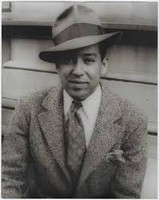Langston Hughes Residence
Introduction
Text-to-speech Audio
Images
Langston Hughes residence in 1930.
.jpg)
Langston Hughes, 1939.

Backstory and Context
Text-to-speech Audio
Langston Hughes (1902 – 1967) was born in Joplin, Missouri in 1902. His grandfather was killed in abolitionist John Brown’s raid on the federal arsenal at Harpers Ferry, Virginia in 1859. Hughes lived as a boy in Lawrence, Kansas, then moving with his mother to several cities in the mid-west. During these moves he fell in love with books and decided that he wanted to be a writer. After high school he spent two years in Mexico with his father, and then, because he wanted to see Harlem, he moved to New York and entered Columbia University in 1921, leaving after a single unhappy year. He entered Lincoln University in Pennsylvania in 1925 and graduated in 1929.
Sponsored by his patron, Langston Hughes moved to Westfield around 1930, where he collaborated with Zora Neale Hurston on writing a play for Broadway. Hughes, like Hurston, became an important contributor to the Harlem Renaissance. Langston Hughes moved from Westfield to NYC in 1931.
I, Too
I, too, sing America
I am the darker brother.
They send me to eat in the kitchen
When company comes,
But I laugh,
And eat well,
And grow strong.
Tomorrow,
I’ll be at the table
When company comes
Nobody’ll dare
Say to me,
“Eat in the kitchen,”
Then.
Besides,
They’ll see how beautiful I am
And be ashamed –
I, too, am America.
Sources
https://en.wikipedia.org/wiki/Langston_Hughes.
Harlem Renaissance, Art of Black America (The Studio Museum in Harlem, 1987).
Hughes, Langston, I, Too, reprinted in Crossing the Danger Water.
Mullane, Deirdre, Editor, Crossing the Danger Water, Four Hundred Years of African-American Writing, (Doubleday 1993).
Donnell Carr
Carl Van Vechten, 1939, The Studio Museum in Harlem
